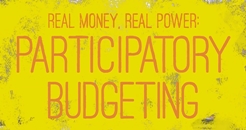 Participatory Budgeting - 1
Participatory Budgeting - 1
From an article by Jake Carlson, Participatory Budgeting Project
We all know budgets for local authorities are tight and hard decisions have to be made about priorities. Politicians argue back and forth and no-one seems to like the outcomes.
Expanding the imagination about democracy could help to focus resources on the projects that are most meaningful to local communities. Through participatory budgeting (PB), people in over 1,500 cities around the world are directly deciding how to spend public money. In the US and Canada, tens of thousands of residents in over a dozen cities have used PB to allocate over $100 million to key community improvements.
Here's an example closer to home. In 2014, the City of Paris started the world’s largest participatory budget (PB). It began as a test-run a few months after Mayor Anne Hidalgo was elected – citizens could vote on how to spend €20 million on 15 possible projects identified by the city.
A few months later they began a full-scale PB, with €65 million city-wide and citizens generating their own project ideas. Between 2014 and 2020, the city has committed to reserving €500 million (about 5% of the city’s capital fund) to be spent through participatory budgeting. In 2016, 158,964 people voted on how to spend nearly €100 million, including €10 million set aside for schools.
In each cycle, there is a PB for each of the 20 Districts to decide on local projects, and 1 city-wide PB for Paris-wide projects. They also specified that €30 million would be specified for working-class neighborhoods in the city. They had 37 city-wide projects, 587 district projects, and 20 school projects submitted for the ballots. 219 projects won. Each project is labeled “fait avec les Parisiens” – Made by Parisians.
Here are some of the lessons learned from the experience of participatory budgeting in Paris:
First of all, it was big – the biggest. It was big both in the amount of money spent, as well as the numbers of people who participated. But size isn’t important for its own sake. In other places we’ve seen that more money for PB means that more people come out to participate. Size is also important because it both reflects how much a city is willing to directly give power to its people, as well as makes things possible that would otherwise be a dream. There is no limit to the imagination of the people. Big budgets can produce big ideas.
Secondly, it was a way to break down political divisions and skepticism. PB gets people to come together around specific projects in their community, and to work them out. Projects come from their neighbours, and not a politician’s office. PB in Paris has come about in a time of an increasingly alienating and divisive political climate – which is not unique to Paris. Many people are against the establishment, they don’t trust their representatives, they don’t trust the system. For Mayor Hidalgo, the PB was a way to increase the power of the citizen and also to make them understand how it works.
It was successful because it had political will. The mayor’s office was fully behind it, and they devoted resources to make it happen. They also created neighborhood-level political will. By offering 2 to 1 matching funds for Districts who put up their own money, they created buy-in from everyone involved (for every euro a district committed to their local PB, the City would add an additional 2 euros).
People were excited about it. Parisians submitted thousands of ideas, and growing each year. With that much money on the table people took the opportunity to put forward bold ideas.
They had great city staff. This is one of the most important factors, but also the most challenging. When PB was first announced in Paris, many did not know all that they were getting into. Paris didn’t grow into big PB – it started big. This meant that city staff had to adapt quickly to a massive undertaking – and they did with amazing commitment and ingenuity. They made some of their work easier, by adopting digital tools to help with voting and idea collection. They also streamlined their work by centrally coordinated idea collection and making ballots, and they relied heavily on digital tools to help with both collecting project ideas and voting on final projects. But dedicated staff time was also crucial to fulfilling PB on this scale.
Paris shows how the possibilities of doing large scale PB, and what it can mean for the people of a city. It is our money after all. What could your community imagine with a large PB budget?
Here's a 4min video to explain:
Here’s some next steps you can take:
Read up about PB here
Make your council aware and ask your elected representative for 5% of the budget to be decided by PB
Check out the Organizing for PB toolkit
See also second blog in this series on impact.
Retweet about this article:
From an article by Jake Carlson, Participatory Bud, 08/08/2017